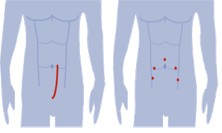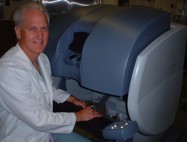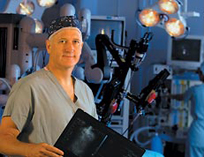The UC Irvine Robotic Prostatectomy for Prostate Cancer Treatment
Surgery for Prostate Cancer : Introduction
With prostate cancer, when conditions warrant, it can become necessary to completely remove the prostate gland in order to reduce the chance of the cancer spreading further. In surgery for prostate cancer, this is known as a radical prostatectomy. While the prostate serves an accessory role in ejaculation ("potency") and aides in stemming the flow of urine ("continence"), it is not essential and can generally be removed with only minor effect on patient quality of life, while greatly increasing patient longevity.
Radical prostatectomy has been performed as an open surgery for quite some time with good success, however as minimally invasive surgery has evolved, it has become possible to perform radical prostatectomies laparoscopically. Recent leaps in technology with the advent of Intuitive Surgical Inc.'s da Vinci robot have taken radical prostatectomy past laparoscopy to an all new level of success. In the hands of a skilled surgeon like Dr. Ahlering, of UC Irvine Medical in Orange County, this new tool allows the radical prostatectomy to be performed minimally invasively with greater precision and ease to both the patient and the surgeon than ever before.
Performing the Robotic Prostatectomy: A Prostate Cancer Surgery General Overview for Patients
 The essence of minimally invasive prostate cancer surgery is to gain access to the involved anatomy via the smallest entry points possible. Traditional open prostatectomies involved cutting open the lower abdomen with a large incision. Predictably, large incisions in traditional surgery for prostate cancer run a higher risk of infection and require significantly more time for the patient to heal, not to mention they tend to leave a large scar. Laparoscopic techniques however, using the da Vinci Robot, bypass this large incision and gain the same access through a few small holes in the skin, each roughly the size of a dime. A small plastic tube known as a "port" is inserted in each hole to keep a channel open for laparoscopic Port Placement image tools to reach through. To allow room inside for the surgeon to work, the abdomen is inflated slightly with carbon dioxide like a balloon. In this working space, the surgeon can perform the same surgeries as if the abdomen had actually been cut open, but without the large incision.
The essence of minimally invasive prostate cancer surgery is to gain access to the involved anatomy via the smallest entry points possible. Traditional open prostatectomies involved cutting open the lower abdomen with a large incision. Predictably, large incisions in traditional surgery for prostate cancer run a higher risk of infection and require significantly more time for the patient to heal, not to mention they tend to leave a large scar. Laparoscopic techniques however, using the da Vinci Robot, bypass this large incision and gain the same access through a few small holes in the skin, each roughly the size of a dime. A small plastic tube known as a "port" is inserted in each hole to keep a channel open for laparoscopic Port Placement image tools to reach through. To allow room inside for the surgeon to work, the abdomen is inflated slightly with carbon dioxide like a balloon. In this working space, the surgeon can perform the same surgeries as if the abdomen had actually been cut open, but without the large incision.
 Through one of these ports a laparoscope, essentially a very small telescope with a camera attached, is passed to allow the surgeon to see inside the abdomen. This is how traditional laparoscopic procedures have proceeded and the techniques are Robot Placement image very well proven and refined. However, in the robotic prostatectomy, instead of proceeding with laparoscopic hand tools and holding the laparoscope by hand, the da Vinci Surgical system is employed. Miniature robot arms and a robotic laparoscope are passed through the ports. These arms and camera are then operated by the surgeon at a remote console.
Through one of these ports a laparoscope, essentially a very small telescope with a camera attached, is passed to allow the surgeon to see inside the abdomen. This is how traditional laparoscopic procedures have proceeded and the techniques are Robot Placement image very well proven and refined. However, in the robotic prostatectomy, instead of proceeding with laparoscopic hand tools and holding the laparoscope by hand, the da Vinci Surgical system is employed. Miniature robot arms and a robotic laparoscope are passed through the ports. These arms and camera are then operated by the surgeon at a remote console.
 The surgeon then proceeds to dissect out the prostate using the da Vinci Surgeon Console image system. The da Vinci system includes a great number of robotic tools that can be swapped in and out on each arm as needed such that the surgeon has every tool he needs. To see what actually goes on inside during this surgery, feel free to visit our Robotic Prostatectomy video page. Additional ports are generally added for an assistant seated at the patient's side to help as necessary with the surgery. Thus most patients will have 5 port sites. The procedure is performed under general anesthesia so the patient feels no pain during surgery and lasts an average of 3.5 hours. At the conclusion of the surgery, the robot is withdrawn and the port holes through the skin and muscle are closed by the surgeon with suture. The patient will awake shortly after in the recovery room, and can generally be discharged from the hospital about 24 hours later.
The surgeon then proceeds to dissect out the prostate using the da Vinci Surgeon Console image system. The da Vinci system includes a great number of robotic tools that can be swapped in and out on each arm as needed such that the surgeon has every tool he needs. To see what actually goes on inside during this surgery, feel free to visit our Robotic Prostatectomy video page. Additional ports are generally added for an assistant seated at the patient's side to help as necessary with the surgery. Thus most patients will have 5 port sites. The procedure is performed under general anesthesia so the patient feels no pain during surgery and lasts an average of 3.5 hours. At the conclusion of the surgery, the robot is withdrawn and the port holes through the skin and muscle are closed by the surgeon with suture. The patient will awake shortly after in the recovery room, and can generally be discharged from the hospital about 24 hours later.
Benefits of da Vinci Robotically Assisted Prostate Cancer Surgery: How it helps the Patient.
* Better Prostate Cancer Control
The true color 3-D high magnification vision, 'intuitive' manipulation of technologically advanced, precisely articulated surgical instruments, and better control of blood loss results in better visibility and precision allowing the surgeon to more carefully identify, expose, and dissect out cancerous prostate. The overall rate of margin positivity of robotic prostatectomy is <19%. More importantly, in men whose cancer is confined to within the prostate, the apical region was correctly visualized and dissected, resulting in very low 6% positive margins in cases of organ confined disease. Prior to the Da Vinci robot, it was very difficult to make such a clean and refined excision of the apical region of the prostate.
* Reduced Hospital Length of Stay for Patients of Robotic-Assisted Surgery
The average hospital stay for patients is slightly more than 24 hours after surgery, regardless of age. Smaller incisions and significantly less blood loss contribute to this fast recovery.
* Minimal Blood Loss with da Vinci Robotic
The average estimated blood loss per patient averages 116 cc. This volume is roughly the 1/3 of the volume of a 12 oz. soda can. Estimated Blood loss has ranged for robotic patients from 25cc to a maximum of 400 cc in the 1st 100 patients. Because of these low blood losses, none of these men required a blood transfusion, nor were they asked to donate autologous blood prior to surgery.
* Urinary Continence after Robotic-Assisted Surgery
Robotic prostatectomy sets an excellent record of continence. Using the definition of zero pads used per day means men will use no pads, not even security pad, although they may have a few drops of leakage during the day. The percentage of men at this zero pad/day standard is 50% at 1 month, and 75% at 3 months after surgery. The remaining men use either a security pad or some number of pads per day at 3 months.
Comparison of Prostatectomy Surgical Options: Open, Laparoscopic, and Robot-Assisted Laparoscopic
| Open Surgery* |
Robot-Assisted Laparoscopic* |
|
| Surgery Time | 3 1/2 Hours | 3 1/2 Hours |
| Hospital Stay | 2 Days | 1 Day |
| Total Incision Length | 5 inches | 2 inches |
| Estimated Blood Loss | 375 cc | 116 cc |
| Visualization | 3 D | 3 D |
| Magnification of Visualization | up to 3X with magnifying glasses |
10-12 X (utilizing a pair of high resolution cameras) |
| Instrument Handling | Normal | Normal (Optional Micro-precision) |
*Data is supplied from UC, Irvine single surgeon, Dr. Ahlering. Laparoscopic data is derived from published literature.
